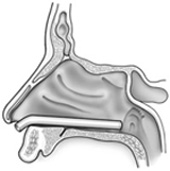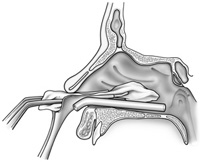We have developed a multi-component system/kit, centered on a one piece, two-tube nasal airway appliance that is inserted by the surgeon following conclusion of the operation. The airways, made of soft latex-free, medical grade silicone, are connected by a bridge.
Packing or any substance, e.g. gauze, absorbable mesh, Telfa pad, Gelform, any PVC product or gel is then introduced.
The airway device provides a certain corridor for adequate air passage through both nasal passages without compromising any packing’s or cavity filler’s important missions.









